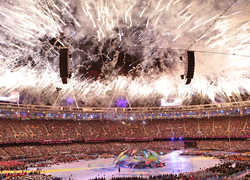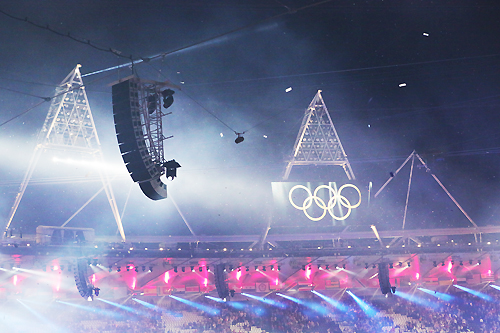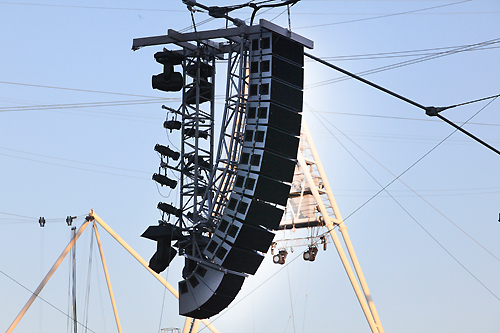
Networking & Signal Distribution
The signal transport and data backbone of the system is based on a four-core optical fiber ring.
Two cores are used for a closed loop Optocore network for all audio signal transport throughout the system. The second pair of fiber connected to managed gigabit network switches. This network was referred to as the Audio LAN.
The audio LAN was managed into four VLAN’s, one of which was for the LA Network. With more than 200 LA8 amplifiers on the network, planning and pre-programming of IP addresses was very important.
Each flown array used six LA8 amplifiers, five for the V-DOSC and one for the ARCS II; each FOP array used three LA8 amplifiers, two for the KUDO and one for the SB28s. So each array needed nine IP addresses.
Noise Pollution
We did not suffer any real system performance limitation due to environmental noise limits. We used a calibrated SPL logger at front of house whenever the system was in use. We had a few complaints from nearby residents during our late-night mixing sessions for the Closing Ceremonies, but given the time, I would have complained too.
Tuning & Commissioning LA Network Manager
Once the contract had been awarded to Delta Sound with the L-Acoustics design, the more detailed elements of system control were discussed.
L-Acoustics was amazingly helpful. We were the first user of their updated LA NETWORK MANAGER software (for the amplified controllers), and I really didn’t want to be the first user to try 223 amplifiers on one network.
They said, “Fair enough. What if we were to plug 223 amplifiers together and test it for a month?” And they did! They used exactly the same IP address that we’d already planned to use and tested it for a month. It was amazing. That level of support is pretty incredible.
Marc Benard, application engineer, electronics at L-Acoustics, explains, “Modern sound designs in arenas and stadiums commonly call for 60 to 80 LA8 amplified controllers. But for the London Olympics Stadium, these numbers were taken to a whole different level with more than 200 LA8 units required. With thousands of spectators in the stadium and billions of people watching the event worldwide there was a bit of pressure on the tech crew.”
“Part of L-Acoustics commitment to this project was to undertake specific quality assurance measures by replicating the complete system at our premises in Marcoussis, France. 200 LA8 were installed in a room, connected to a redundant AES/EBU and analog audio distribution, and controlled over a fault-tolerant fiber optic ring network using exactly the same Ethernet switches running the same protocols as that of the Olympics.
“All were controlled from a single (and relatively basic) Windows XP computer using the recently released LA NETWORK MANAGER V2 remote control software that features a complete system event messaging system. This allowed us to challenge the resilience and responsiveness of our platform. These improvements now benefit all users worldwide whether they use a couple of amplified controllers for a local gig or they are on tour with the most popular artists around.”
The software performed well and I felt confident from L-Acosutics’ experimentation that the software was ready for use on the project.
Using The Software
Prior to London 2012 I had used L-ACOUSTICS products on many projects, but only a few with LA8 amplifiers, and fewer still where I made use of the LA NETWORK MANAGER software. Loading presets into amplifiers was very fast and the various viewing options provide great feedback during commissioning and usage.
The grouping facility of the software is excellent, allowing subtle EQ or delay changes to parts of the system very fast and reliable. The grouping also helps with muting large parts of the system very quickly for certain rehearsal situations.
Justin Arthur, patch systems engineer from Norwest Productions, spent the most time on the software and he found it easy to use, fast and reliable. He states, “L-Acoustics were a pleasure to deal with while working on the London 2012 Games.
“Marc Benard and his team were there right from the start testing the large network of amplifiers in their office months out from the load in of the event. Throughout the event they were always there on the phone and via e-mail to answer any questions. They even wrote a new version of the software for us when we found a bug in the previous version.
“LA NETWORK MANAGER was very simple and very easy to use. All the information you need to monitor the system is right there on one page. Grouping and monitoring has improved vastly from Version 1 of the software and it is also much more user friendly.”
Also the file size for a network with over 200 amplifiers was only a couple of hundred KB. so it provided very easy to manage files.


